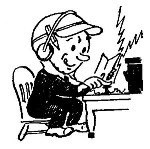…what was the question?
Whether ’tis nobler in the mind to understand dB or just plod along wondering what the heck other hams, publications and spec sheets are talking about is up to you. With all due respect to Shakespeare’s Hamlet, decibels (dB) are a frequent subject in ham radio. All three US license class exams have questions involving dB in their pools.

Hams new and old don’t have to be technical experts but all should at least be familiar with the decibel. To that end we will give a simplified explanation here.
Decibels (dB) are a convenient and standardized way of measuring a change or difference between two conditions. In audio, radio work and electronics in general, we are often dealing with very large or very small numbers and the difference between them can be many digits long. To make the numbers more manageable, expressing ratios of large and small values is better done using a non-linear logarithmic scale. Logarithms are based on orders of magnitude (10,100,1000,10000… and 1/10, 1/100, 1/1000, 1/10000…).
The human ear responds to sound logarithmically so decibels are a natural fit to measuring sound levels. Similarly, radio work behaves non-linearly in some ways so the logarithmic approach works well here. We’re stuck with dBs, like it or not. In amateur radio the dB is commonly used in context of amplification, feedline loss, antenna gain, filter bandwidth and RF signal strength.
Technically the decibel is a ratio between one state and another; it’s not an absolute measurement, it’s relative. Always ask, dB relative to what?, because this is a ctitical factor.
More practically it often comes down to the amount of amplification or attenuation. In amateur radio it almost always involves power changes so we will focus on this aspect. Decibels can also apply to other units such as voltage but this gets a little more complicated and not as widely used in ham radio.
A power ratio is simply comparing two wattages logarithmically in the form of

Even if you’re a mathaphobe, that’s not too bad, right? Divide one power by the other and take the logarithm of that, then multiply by ten.
The practical upshot of this simple math means that even small changes in dB indicate large swings in power. This is easy to see from the table below:

30dB is a thousand times relative power while 60dB is a million times!
Notice halfway down the chart at 0dB, which represents no change in power (ratio or factor of 1:1). Above 0dB are positive dB values and below they are negative. Positive dB values indicate net gain (amplification) while negative values mean loss (attenuation).


One beauty of the decibel system is that it is cumulative, meaning you can add gains and subtract losses to arrive at a final dB value. For example, a -3dB loss plus another -3dB loss = -6dB total, which would result in 1/4 of the total power output, according to the chart above.
Adding and subtracting dB makes it easy to determine the overall system or circuit output. Consider this Extra class exam question:

Looks complex but really isn’t. Add the three loss values (2, 2.8, 1.2) to get -6dB attenuation. Then add a positive 7dB antenna gain and you have net 1dB. Knowing this is 1/3 of 3dB (3dB=double power), we know that the result would give us amplification of more than 0 and less than 2, close to 1.2. The only answer of the four choices that gets us slightly more than the 200W transmit power is 252W.
You don’t need a scientific calculator to work out most power calculations if you remember the Rule of 10s and 3s. Memorizing these two facts will help you in maybe 9 out of 10 situations, assuming you can do simple math in your head:
- 3dB is about twice (or half, if negative) power
- 10dB is exactly ten times (or 1/10th, if negative) power
For example if you have 23dB amplification of a 0.5W signal, you would take 10x the input (=5W), then a ten times that (=50W), then double that (=100W output). A great video link is given below for how to use the Rule of 10s and 3s.
To clarify what is being measured in dB, sometimes a suffix is added:
- dBm- one milliwatt (1mW)
- dBW- one watt (1W)
- dBV- one volt (1V)
- dBµV- one microvbolt (1µV)
- dBFS- Full-scale value
Antenna performance always being relative, you will usually see the clarifying suffix i for isotropic antenna (dBi) and d for dipole (dBd) when referring to antenna “gain”.

The roots of the Bel unit (resulting in decibels) go back to the earliest days of the telephone. It arose out of the need to quantify how loud a sound was at the receiving end of the line. The ratio of received over transmit strength was born and named in honor of the telephone’s creator, Alexander Graham Bell. Straight Bel units (1Bel=10x change) yielded numbers that were often too large to measure and harder to calculate (both 100 years ago) so they started using 1/10Bel (decibel) as the standard.
For those who want to understand the subject better or get more technical than this brief explanation, there are many good resources in books, magazines and on the internet regarding the subject of decibels. Here are some web links that are particularly useful:
Ham Radio School article
The Rule of 10s and 3s video
The dB Explained video
Ham Radio Basics–Decibels in Five Minutes video
A Tutorial on the Decibel ARRL document

Good information and references. Thanks Jim.
LikeLike